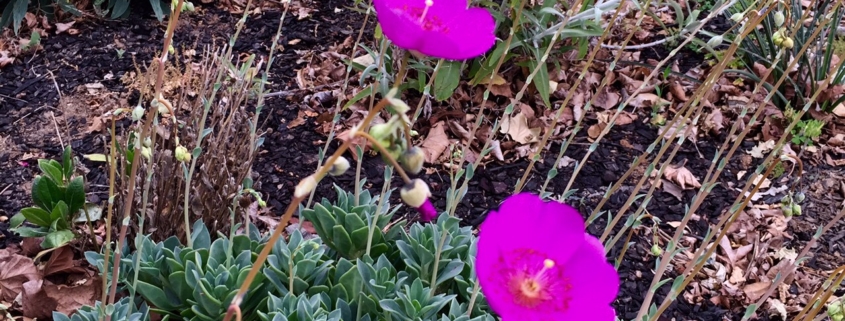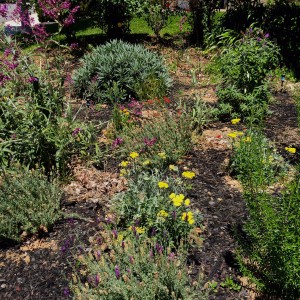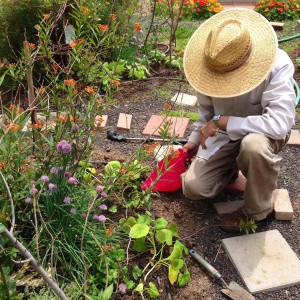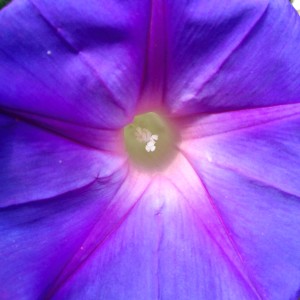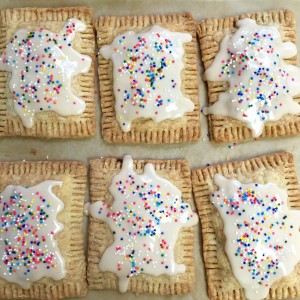Secret Gardens, House Finches, and Apricots: Finding Voice and Purpose In Mundane Moments
To the right of my house, hidden past four raised beds of squash, tomatoes, eggplants, peppers, and cucumbers, further past two wild patches of mint, there is an old secret garden. There, morning glory grows wild, climbing our two-story house, twining into our rain gutters, pulling them down, and covering our wooden fence. There, also, mature rose bushes thrive. Each spring these roses house hummingbird nests, give me fragrant roses to bring inside, and send out wild shoots of rose plants. Though it is easily seen from our dinning room’s large picture window, it is the piece of land I spend the least time attending and caring for. In truth, I can hardly call it a garden; it is a wild, untamed patch of our home with its own story.
As our main garden has slowly filled in with vegetable plants, fruit and avocado trees, wild-growing blackberries, and herbs too many to name, I’ve turned to other places to cultivate and plant. Last summer, for example, Edward and I painstakingly pulled up our front lawn with pix-axes over a hot and humid July. In the midst of California’s current historical drought, it made no sense to continue pouring water into a lawn that refused to stay green, and only fed and sheltered grubs. Now, nearly a full year later, it is full of native western plants. Swallowtail and monarch butterflies, finches, sparrows, dragonflies, and bees gather and call it home. Our native garden is young, still finding its voice, but it has already begun to sing its song and tell its story.
The air above the native garden is a highway—swallowtails skidding to the backyard, hummingbirds sitting a spell on tree limbs, bumblebees wrestling their fat bodies into the throat of violet morning glory blooms, and June bugs flying drunk in airstreams. Even the leaves refuse to die without saying something—singing loud, final songs, as the same airstream carries them down the sidewalk. I cannot help but be reminded, witnessing the young voice of my native garden; we all have our own songs and stories, too.
This week, while attending to the wild, secret garden, I wondered about its story. What song, what story, what purpose does it hold? Last fall, Edward and I installed a raised bed there, a place to grow shade-loving vegetables like carrots and lettuce through our hot summers.
“Isn’t it too shady to grow anything here?” Edward asked while I arranged the cinder blocks for the bed. “Don’t you need more sun?”
“It’ll be an overflow and experimental bed.” I stopped and started talking excitedly with my hands. “I can try new plants out, finally figure out how to grow carrots, probably even grow lettuce in August.”
Truthfully, I did not have a sure answer to his questions; I do not know if shade will help me produce more food, or if more sun is always better. I see the bed as an opportunity to figure those things out. Our summers here in California’s Inland Valley are brutally hot. Weeks pass, one after another, stacking days upon days of triple-digit temperatures. Heat-loving tomatoes stop growing, and everything but citrus takes a break August through September.
Edward followed my lead, and went about filling the cinder bed with soil. Not long into his work, he came running from around the corner, finding me in the main bed. He was not running excitedly to tell me something, or bring me to see something he’d discovered, he came running from a hummingbird. Though we had neglected this garden over the years, she had already begun to sing her own song, to write her own story full of characters with lives and purposes of their own. We learned we are just visitors, and hummingbirds are very territorial.
When Edward went back, he worked more respectfully, taking up less space and being mindful of the nest in the rose bush the hummingbird was protecting. Eventually, the bed was raised, and last season we grew Brussels sprouts and trochuda cabbage. I’m still trying to figure out the carrot thing, however.
But something else has begun to happen. This garden has begun to teach me about what we do with our lives, how we live out our purpose in ordinary time, more specifically, how we live out the quiet moments of our lives.
Last week, my two and a half years of creative writing study culminated into a final thesis. It is 177 pages with its title pages, acknowledgments, table of contents, etc., but more specifically, it is 52 pages of poetry, and 102 pages of fiction. Somehow, during my pursuit of becoming a better novelist and completing my first novel, I wrote a poetry book, and became a poet.
As my mentor signed off my final manuscript, and I realized my poetry book was full and complete, hollowness set in. For the past seventeen months, those poems were my creative focus and purpose. I poured myself into writing those poems, then editing them, arranging them, naming, and polishing them. They gave my writing life purpose and dedication.
Today, with the extraordinary moments witnessed and recorded in that poetry book, what do I do with the ordinary time of today, until the next moments of reverence for a new subject comes? What about tomorrow, after the book, the degree is finished? While working through extraordinary goals we often think that work and that effort is hard and demanding, but I have come to differ. The hard work is witnessing the mundane, the quiet, the ordinary time of our lives and finding the same passion, grit, reverence for those silent moments as we have for the loud moments we can announce on our social media streams. Those quiet, dusk moments of our lives without enough light to photograph. Who are we then? When we put the projects down, who are we; who are we when we settle down with ourselves, come down from the high of extraordinary, and live in ordinary time?
While sitting on the edge of a cinder block, in my secret garden, planting a Black Diamond Watermelon, a bird flew from the gutter above me and around to a heavy thicket of morning glory vines. Perched, it began to chirp amongst a chorus of chirpers, and soon after, a hummingbird flew out, dipped its body near my head, before flying off into a nearby tree, out of sight. I turned my attention back to the bird singing from the morning glory vine, noting its strawberry red throat, its tan body, and short-pointed beak, all clues to help me discover the name of this rare visitor. A few hours later, while sitting still with my journal, I noticed the same bird sitting on a branch, eating a ripe apricot across the yard. His strawberry pink throat matched the blushing apricot and as he took moments to pause between pecking at the apricot, he’d sing a quick note.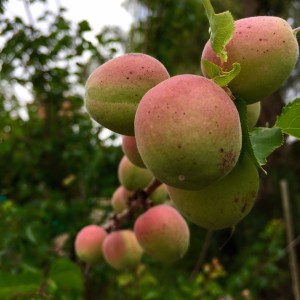
I had to fight myself to sit still, to watch him from afar, knowing if I came close, he’d scurry off and leave his afternoon lunch. Some minutes later, when he flew off, I started poeming. Once I realized he was done eating the apricot, and not coming back, I walked over, sat beneath the tree and decided to poem from there, with the sun on my arms. On the ground a half-eaten, ripe apricot caught my attention. I held it, inspected it, pushed my nose into its cleaved flesh, smelling the sweet, musky floral scent of a sun-ripened apricot. I instantly knew why my feathered visitor kept singing.
I left space in my poem for the bird’s proper name, something, I imagined, rare sounding that I’d never heard before. A name to give my poem a flair of the extraordinary. Later, after going through my regional bird book, and researching online, I learned this fellow was an everyday house finch. Colorful in his mating plumage, I failed to notice the ordinary in the extraordinary in front of me. Or, is the bigger truth that I failed to have reverence and awe when witnessing the mundane.
This, my friends, is what we do in the quiet, humdrum time of our lives. We follow the paths of birds, we investigate and smell sweet fruits in the sun, we get still and listen to the birds sing, the bees humming their glassine wings—this is where we truly find purpose, passion, and meaning, when we are wildly present and able to see the extraordinary in the ordinary. It is this time, between the extraordinary seasons of our lives, which defines us and guides us towards our purpose(s).
I believe we truly live during ordinary time. Not the big moments, but the quiet moments. Those times we are preparing for the bigger moments, we are writing the stories and singing the songs under our breath, waiting for the extraordinary times to sing our stories on the big stage. The big stage is for the world, but the quiet, everyday moments are for us, for us to be present and purposeful in song.
I’d like to share a recipe for a quick hand pie to eat during your ordinary, in between time. It is just as comforting as a morning treat with coffee or tea, as it is in the evening, warmed for dessert. To my kids it’s a homemade pop tart, to Edward and me, an old-fashioned hand pie. Either way, it’s homey and good in the best kind of way.
Boysenberry Hand Pie/Pop Tart
The best thing about these hand pies is the contrast between the tart berry filling and the sweet icing on top. The flaky dough serves as the perfect backdrop; it’s sweet enough to help round out the tartness of the boysenberries, but not too sweet. I use a good quality vegan margarine for my dough, but feel free to use all butter. The key is ice-cold margarine/butter, ice-cold water, and quick handwork. Of course, you can use what ever flavor of jam you like!
Pie Dough
3 ¾-4 C. all purpose flour
3 sticks of margarine/butter, diced and ice-cold
3 tbl. Sugar
¾-1 C. ice-cold water
Directions:
- An hour before you plan to make your dough, cut up your margarine/butter into cubes and put in the freezer. Chill 1 cup of water.
- To Make Dough: Measure 3 ¾ cups of flour into a large bowl, add the sugar, and mix well to incorporate. Add the cubes of butter, and then cut it into the flour with a pastry blender/cutter, or two forks. When the butter is the size of small peas, slowly stir in the ice water. Start with the lesser amount of water, and add enough extra water to make the dough hold together. It’s okay if there are dry areas. If the dough is too wet, add in extra flour.
- Separate the dough into two disks, wrap in plastic wrap, and put in the refrigerator to chill. In the meantime, make your filling.
Boysenberry Filling
1 C. seedless boysenberry jam
Squeeze of lemon juice
1 tsp. freshly grated lemon zest
1 tbl. cold water
1 tbl. cornstarch
Directions:
- In a small saucepan, add the jam, lemon juice, and lemon zest. In a separate small bowl, mix the water and cornstarch to make a slurry. Add the cornstarch slurry to the jam, and cook over medium high heat until the jam begins to thicken, about 3-4 minutes.
- Once thickened, put the jam in a small bowl, and set aside to cool. (Note: to cool quickly, place the small bowl of jam into another larger bowl filled with ice water. Stir the jam continuously, until it cools and thickens.)
Assembling the Hand Pies:
- Cover your work area and rolling pin with flour. Roll out the dough into a rectangle roughly 9 x 15 inches long and about ¼ inch thick. Cut the rectangle into nine rectangles, about 3 x 5 inches big. Set aside, then do the exact same thing with the rest of the dough. (You may have dough left over.)
- In the center of the first set of rectangles, spread about 2 tablespoons of the thickened jam, avoiding about ½ inch of the edge. Be generous, but also mindful that if you put too much jam, it will squeeze out when you put the top layer of dough on top. Too little, and your hand pie will be dry.
- Once each rectangle is spread with jam, moisten your finger in water and wet the edges of each rectangle (the ½ inch area without jam), and then place one of the second set of dough rectangles on top. The water will help seal the two layers of dough together. With a fork dipped in flour, press around the edge of the pie, crimping the two pieces of dough together. Set aside, and repeat the process with the remaining pieces.
- Preheat the oven to 350 degrees, and place the prepared pies into the refrigerator to cool while the oven preheats, about thirty minutes. This gives the margarine/butter a chance to harden again, which helps to create flaky dough.
- Cook the cooled pies for 25-35 minutes, or until they are golden brown. Set aside to cool while you make the icing.
- Icing: To make the icing, mix 1-1/2 cups of powered sugar with 2 tablespoons of milk, 1 tablespoon of vanilla extract (or less if you prefer, but I always use a lot of vanilla), and 1 teaspoon of light corn syrup (optional). You do not have to add the corn syrup, but I find a little helps the icing to not flake off it dries. Whisk well, adding more sugar to thicken, or milk to thin until you reach your desired consistency.
- Ice the cool pies, shake on candy sprinkles, and enjoy!

